There are lots of reasons why an RV roof vent fan is an important component of any RV, but until you’ve lived in an RV for a little while (or full-time for nearly two decades in our case), you can’t fully appreciate the value of this relatively inconspicuous feature of an RV’s ceiling and rooftop.
In today’s post, we’re focusing our attention upward – to one of the coolest elements (see what we did there?) of any type of rig – the RV roof vent fan. We’ll tell you why you need one, how they work, what you need to know if you’re in the market for one, and what we think are three of the best options available on the market today.
If you’ve never lived in an RV, even for a few days, what we can tell you from considerable experience is that this is a more important topic than you may think. So, let’s get right to it.
Why Do You Need an RV Roof Vent Fan?
A fan is a fan, right? It blows ambient air around or directly on you, and that’s that. Right? Not so fast! The vent fan embedded in your RV’s roof has a number of purposes, all of which are crucial to RV living. Let’s start by looking at the top three reasons why every RV needs a roof vent fan (for more info, read “RV Ventilation Is Important For Your Comfort & Health!“).
Temperature Control
An RV roof vent fan is critical for temperature control.
An RV is a relatively small box. Ventilation is important, and it can’t usually be accomplished by opening a window or two on the side of the RV, especially if the air outside is particularly still.
Venting air up through the roof allows for air circulation throughout the RV. And if you’ve never experienced how well a good quality RV vent fan accomplishes full-house air circulation, you’d be surprised at both the effectiveness and efficiency of this 14” square area of your rig.
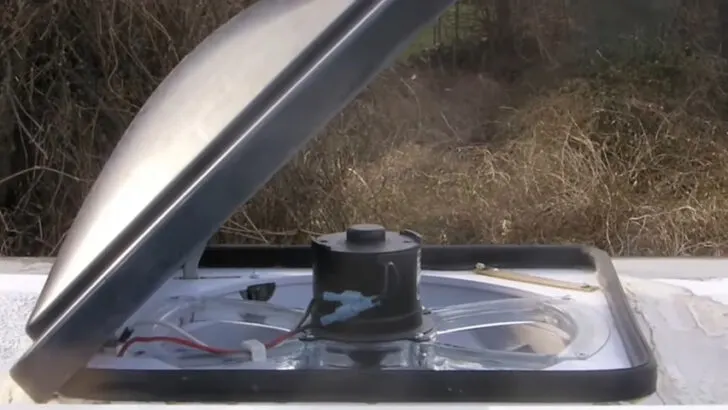
RV roof vent fans are extremely effective at improving air circulation and temperature control in an RV.
RV temperature control in all but the hottest conditions can be achieved with the operation of a good RV roof vent fan. Running the fan even on a low setting and cracking open a window can usually cool an entire RV quite comfortably. Even on a very hot day, it can make a huge difference.
This not only keeps you and your pets safer and more comfortable, but also means there’s less need to run your air conditioner. An air conditioner is a power hog, and isn’t always practical, or even available. An RV vent fan, on the other hand, sips power as it moves air through your rig. More on that after we look at a couple of other important reasons why your rig needs an RV roof vent fan.
Moisture Control
Moisture is a well-known enemy of all types of RVs. When moisture is allowed to accumulate, bad things happen. These “bad things”, better known as mold and mildew, are not only hazardous to the health of every living thing inside your RV but can also contribute to the deterioration of the RV itself.
The problem is that it’s very easy for moisture to accumulate in an RV. From showering to condensation contributed by the weather to moisture from cooking, making coffee/tea, and even breathing, moisture can quickly accumulate in an RV. This is why moisture control is one of the three most important reasons to have a working RV roof vent fan in every rig.

Steam created by cooking, showering, and even breathing contributes moisture to the air inside the RV. If not vented to the outside with a roof vent fan, accumulated moisture can lead to problems like mold and mildew.
Venting Cooking Odors
Speaking of cooking, in addition to removing the moisture from cooking in your rig, an RV roof vent fan also vents cooking odors. Imagine having no way to vent the odors of cooking seafood in your RV? How about cauliflower? Garlic and curry? You get the idea.
Venting cooking odors from a small living space is a good idea and is a third reason why every rig, regardless of size, needs an RV roof vent fan.
Do RV Roof Vent Fans Work?
RV roof vent fans do work, and the good ones work really well. All three of the purposes noted in the section above are very well served by a good-quality roof vent fan.
Good ventilation is one of the most important considerations to give to the experience of living in a small space. If you’ve ever endured a hot, stuffy night or a period of high humidity when camping, then you likely have a first-hand understanding of the need for a good roof vent fan.
If you’ve ever been in a vehicle with all the windows closed and the engine off, you may have noticed fog and even water (or even frost on a cold night) building up on the windows. That’s moisture accumulation occurring just from breathing and speaking. The same thing occurs in an RV. But moisture build-up can be reduced exponentially when you run your vent fan.
Good ventilation is absolutely necessary in a small space, whether you’re in a small campervan or a large Class A motorhome. And windows alone often can’t do the job. Even with a cross-breeze hitting your rig just perfectly, sufficient airflow is enhanced with the aid of a good roof vent fan.
We’ve got a lot of experience living in an RV, and our current 43-foot motorhome has not one, but two roof vent fans. Do we use them? You bet we do. All the time. Do they work? Absolutely.
We can vouch for the RV roof vent fan as a highly effective means of ventilating an RV of any size.
What to Look for in an RV Roof Vent Fan
Let’s take a look at some of the most important features to look for in a good RV roof vent fan.
Air Flow
Airflow is one of the most significant factors when considering the installation or replacement of an RV roof vent fan. Unfortunately, many fans installed by RV manufacturers have tiny motors and very small fan blades that move very little (if any) air.
Those fans are nearly useless – a step above no vent fan at all. The difference a high-quality RV roof vent fan makes in terms of airflow and air exchange is immense. There’s no comparison.
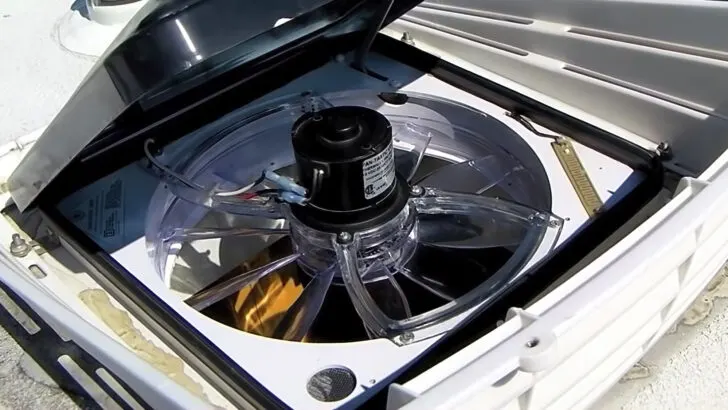
A good RV roof vent fan has multiple blades that produce significant airflow while using very little power.
A vent fan should provide good airflow, even at the lowest speed, so that the ventilation is adequate even when the fan is using very little power. (More on that later.)
Speed Options/Controls
Some RV vent fans have more options and controls than others. A fan may have just a few speeds or it may function at many different speeds.
Some fans offer a remote as part of the package so that you can control your RV roof vent fan from anywhere in your rig – the couch or your bed, for example – depending on the size of your rig, of course. Some controls are mounted right on the fan itself, and others are wall-mounted. If they’re on the fan itself, how high are your ceilings, and are you tall enough to reach them?
There may also be controls related to temperature settings and direction of airflow (out only, or both in and out). Again, more on that below.
Manual/Automatic
Some RV roof vent fans (the most basic type) are fully manual. That means you need to rotate the knob that opens the lid, then select the speed you want — usually a choice of low, medium or high. This type of fan wouldn’t likely be a great choice for a 5th wheel with a high ceiling, as many people wouldn’t be able to reach it.
Fans with automatic features can control a few different things. For example, when we use our wall-mounted controls to turn the fan on, the push of a single button fully opens the lid, and turns the fan on.
But there’s more. Each of our automatic fans is equipped with a thermostat, so they can be set to increase or decrease their speed based on the temperature in the RV as the day warms up. When we do choose the “manual” setting, we have far more speed choices than just low, medium or high. We can select from about a dozen different speeds, giving us much more control.
Rain Sensor Feature
This is a bigger deal than you may think. But there are a couple of important factors to keep in mind where a rain sensor is concerned. You may not want the traditional rain sensor feature you’re thinking of as you read this.

Here you see the rain sensor on one of our two Fantastic fans. Is a rain sensor your best bet for keeping rain out of your RV while allowing the air to circulate? As it turns out, the answer is no.
Let’s break this one down a bit:
Some RV roof vent fans have a built-in sensor that senses rainfall and upon that recognition, closes the lid automatically. That sounds like a great idea, right? Well – sometimes. Here’s the dilemma, at least with some versions:
Let’s say you leave your rig on a very warm day and before doing so, you open the lid of your roof vent fan and turn the fan on low to keep the air circulating so the heat doesn’t build up in your RV. You head off for a long hike feeling confident in the rain sensor feature of your vent fan because you know that if it starts to rain while you’re away, the lid will close, protecting your rig from the rain.
But suppose it rains, the lid closes, and then the sun comes back out and the ambient temperature rises significantly while you’re away. Now you’ve got a fully closed-up RV with no ventilation at all. This is bad enough if your rig and everything in it is heating up as the temperature rises, but it could be catastrophic if you left a pet in your RV even for a very short period of time.
This is no minor consideration – it’s huge. If you run to the grocery store in your toad and you leave your pet in the RV with good ventilation and cooling from the vent fan you left running, and it rains and the lid of your vent closes, you’ve now got a pet inside a rig with a dramatically rising temperature.
We don’t travel with pets, but we know many people who do, and the very last thing they would ever want to do is bring harm or even discomfort to their beloved four-legged best friends. In reality, you probably shouldn’t leave your pet in the RV if hot weather of any kind is a possibility, unless you’re hooked up to shore power with the A/C set.
NOTE: Our fans have rain sensors that will re-open after the sensor dries out. Once it does, the fan will automatically re-open and run again. But if it’s still raining, it will only try to re-open three times, after which it will stay closed until we intervene.

This little guy is way too important a member of your family to leave vulnerable to the potentially unreliable operation of a rain sensor.
The point we’re trying to drive home here is that while an RV roof vent fan with a rain sensor may sound like a great idea, there are other considerations to be made, and there are better ways to deal with the potential for rain to enter your RV through the vent fan.
We’ll take a look at those now, but we first wanted to sound the trumpets on rain sensors just so that folks are aware of how they work. But even though rain sensors may prevent your RV from getting soaked, wouldn’t it be better to simply allow the fans to continue providing ventilation even if it starts raining? More on that below.
RV Vent Fan Lid
Following along with the rain sensor feature, let’s take a closer look at the vent fan lid.
We’ve already established that some vent lids close automatically when the rain sensor detects rain. And as we mentioned, there are some fans with rain sensors that close the lid when rain is detected but then re-open it automatically after a certain period of time, or when no moisture is detected.
You might think this would address the pet danger noted in the previous section, and usually it probably does. But how many times will an automatic lid close and reopen until it simply stays closed? How much rain does it take for a rain sensor to detect rain? What if the rain sensor fails and the lid doesn’t automatically close, even in hard-driving rain? How much damage could this cause to your RV?
All of these questions illustrate the significance of a roof vent fan’s lid, particularly as it operates in tandem with the rain sensor.
But there’s a better way to deal with these concerns and potential issues, which we’ll get to in the section below about fan covers (not to be confused with fan lids).
Reversibility
Some RV vent fans only pull air out of the RV, and some are capable of pulling air out or into the rig. These are reversible fans, and not every vent fan has this feature. So, if you want to be able to pull air into the RV from above, be sure to buy a fan that has this feature of reversibility.
Power Consumption
This one is important to boondockers everywhere. When you’re not hooked up to shore power, it’s important to conserve power. When you’re off the grid, your vent fan will draw power from your RV’s 12V “house” batteries (the same ones that power your lighting, water pump, and other 12-volt items).
Despite the fact that we have a huge solar array and battery bank, we keep our eyes on our power consumption when we’re off the grid. And for many RVers, especially those with smaller battery banks, it’s important to count every amp-hour they consume, or they’ll be likely to run out of power.
This makes the power consumption of an RV roof vent fan important, especially if you want to run the fan overnight or even all day.
With that said, high-quality RV roof vent fans tend to use very little power even when running at maximum speed. The most powerful fans will use between 3-5 amps running at full power. When running on the lowest speeds they’ll consume little more than 1 amp.
This low power consumption is one of the greatest features of high-quality RV roof vent fans. But when you’re shopping for a fan, the power consumption of the unit may be an important consideration.
Price
And finally, we all have a budget and price is always a consideration. You need to buy what you can afford and what you’re comfortable with. Just remember to factor in things like power consumption or you may find yourself wanting to install more battery power or replace the fan with one that uses less power. That would likely offset any cost savings you may see with a cheaper fan, by buying the one that’s really right for you in the first place.
Do I Need RV Roof Vent Fan Covers?
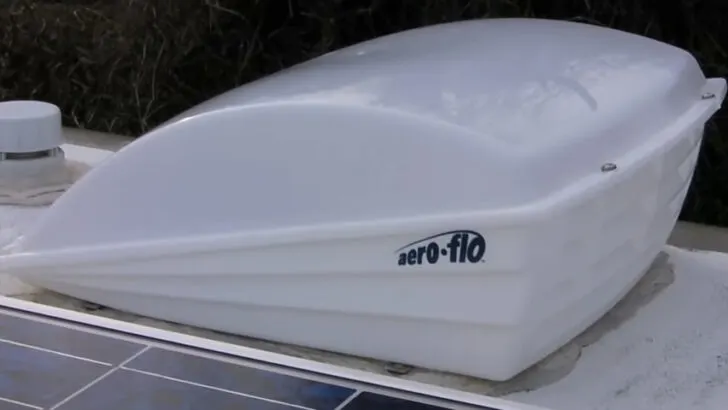
RV vent fan covers like our Camco Aero-Flo allow us to leave the vent fan open 24/7 without worrying about the potential for rain. These covers allow for excellent airflow in addition to protection from the weather.
For us, the answer is yes, but as always your mileage may vary. Can you use and enjoy your RV roof vent fan without a cover? Absolutely. Will you appreciate having a cover over and over and over again? You bet you will, and here’s why:
In the scenario we offered earlier, where we considered relying on the vent fan to keep our rig and our pets safe, we relied on a rain sensor to close the lid if it detected rain, and found a less than desirable result.
Given the same scenario – we leave the RV for a while and the sun is shining and our fan is running but later it starts to rain – but this time we have a vent fan cover on the roof, we can allow the lid to remain open even if it rains. We’ll still have excellent air circulation, but we’ll also have protection from the rain.
Vent fan covers are also designed for easy opening to give access to the fan for cleaning.
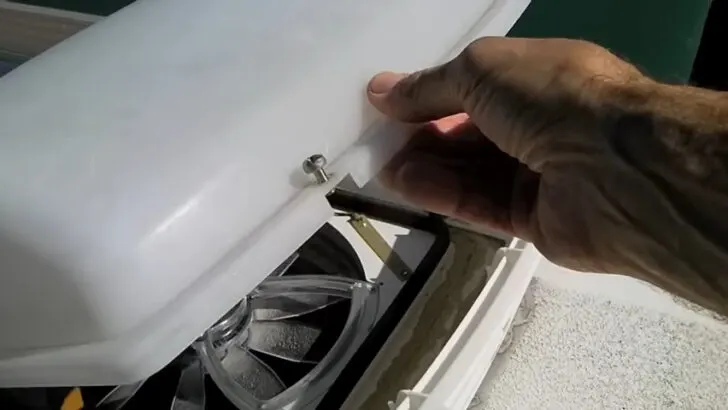
The lid of our vent fan cover can be opened easily and quickly for cleaning with the loosening of two Phillips head screws.
Here’s another scenario for you: You’ve got your roof vent fan’s lid up and you drive away. Guess what happens.
That’s a big oops, and now your lid might need to be replaced. More importantly, until you can get a new lid installed, you’re taping plastic to your vent to keep the rain out. Hardly an ideal situation!
You could even go to bed one night with your lid open and your fan running, offering a nice cool exchange of air as you sleep. Along come some high gusts of wind and…you guessed it…you’ve lost your vent fan’s lid.
So, for lots of reasons, you’ll definitely benefit from a cover over your RV roof vent fan. These allow you to keep your vent open in the rain while still offering great airflow, and you can even leave it open while you drive if you wish. Since rainy weather is one of the most important times to ventilate the RV (to reduce moisture and humidity), we would never be without our vent fan covers.
If you’re interested in installing a roof vent fan cover, feel free to follow our step-by-step guide to this easy DIY project.
Are RV Roof Vent Fans a Standard Size?
The standard size of a roof vent fan found in most RVs and campers is 14” x 14”.
If you’re in the market for a new vent fan, however, be sure to take a quick measurement, because there are some vent fans that are 11” x 11”.
PRO RV TRIVIA: RV roof air conditioners also utilize the same standard 14″ x 14″ opening. That means you may actually be able to replace an RV roof vent fan with an A/C unit by simply running the electrical connections. The opening is already there!
The 3 Best RV Roof Vent Fan Options
With all of the above information in mind, the following are the two top options for a high-quality RV roof vent fan, along with a third, slightly less expensive candidate deserving of an honorable mention.
Maxxair MaxxFan Deluxe 7500K
The most expensive unit of the three we’re highlighting is the MaxxAir MaxxFan Deluxe 7500K.
- Powerful 10-speed intake and exhaust fan
- Thermostat to control room temperature
We don’t have a Maxxair MaxxFan, but we know lots of people who do and if we were ever to find ourselves needing to replace the Fantastic fans that came with our rig, this unit would most likely be at the top of our list.
We say this not because it’s a better fan than the Fantastic fan overall, but because it has a few additional features we really like, including a built-in cover that has a low profile but still offers excellent airflow and protection from the weather.
The Maxxair MaxxFan has a powerful intake and exhaust fan offering over 900 CFM with 10 speeds and a thermostat to control the temperature of the room. (CFM stands for “cubic feet per minute”, and is a measure of how many cubic feet of air the fan exhausts or takes in every minute at full speed.)
The MaxxFan has an electric lid opening with remote control and fits all standard 14” x 14” roof openings. The lid can be brought flush with the roof for improved aerodynamics.
This fan is noted to consume less than 1 amp running at low speed, and just under 5 amps running at the highest speed.
A quick note for anyone installing this fan in an alternate (non-RV) application: The voltage needs to be a fairly consistent 12.8V. Many reviewers using the fan in a different application note that the control boards on these fans (and probably others as well) can’t handle the voltage range supplied by a vehicle’s alternator (often fluctuating fairly dramatically between 13.9-14.5V and higher) and has been known to regularly blow these control boards. In an application where the supplied voltage is significantly greater than (or dramatically fluctuating around) 12.8V, a voltage regulator is recommended.
Bonus note: Maxxair makes similar fans with fewer features that are less expensive and have excellent reviews. For example, this Maxxair Vent Corp fan has only 4 speeds, manual lid opening, and is an exhaust-only fan.
- 4-Speed Fan Motor with 12" Fan Blade moves over 900 CFM of Air, Exhaust Air Only
- Built-In Rain Shield
Fantastic Vent Fan Model 7350
Fantastic is the brand of fan we have in two locations (kitchen & bathroom) in our RV.
The Fantastic fans are – well – fantastic! We have absolutely no complaints after nearly 17 years with these two fans in our current rig, and we can certainly vouch for their reliability. They’re still the originals that came from the factory, and neither one has ever required repair.
- 14 fixed manual speeds or automatic variable speeds for customizable ventilation; Reversible airflow switch for efficient temperature control
- Built-in rain sensor with automatic open and close function for protection against the elements; manual knob closes the fan in case of emergency
These fans have a very low amp draw, are rain sensor-equipped, have a built-in thermostat, and can be controlled by the included remote. The remote controls both the 13 speeds as well as the temperature and can also open and close the lid.
We’re very happy with our Fantastic fans, despite the fact that we did have to install covers over them so that they can be used in any kind of weather without concern.
Leisure Coachworks Manual Fan
Our honorable mention goes to this Leisure Coachworks Manual RV roof vent fan.
- Leisure Coachworks RV Roof Vent Fan 12V with 1 speed in and 1 speed out and Smoked Lid. You can easily open and close the hood with a manual riser....
- Compatible with a 2" to 4-1/2" thick roof,fits standard 14" x 14" openings
This fan gets some very good reviews despite being a single-speed 10-blade fan. The fan is reversible, offering one speed air-in, and one speed air-out. The fan is advertised to use 5 Watts, and it fits the standard 14” x 14” opening.
The hood is opened and closed manually and is easily installed with its 2-wire design.
Which RV Roof Vent Fan is Better? Fantastic Fan or MaxxAir?
In truth, there is no clear winner overall, but your “winner” will likely be feature-dependent.
While the Fantastic fans have a well-earned reputation of excellence and durability, the Maxxair fans have some additional features to offer, most notably the sleek built-in cover which precludes having to buy and install an aftermarket cover (although we do love our Camco Aero-Flo vent fan covers).
The Leisure Coachworks fan has some good reviews and, for the $120 price tag, might fit some budgets just right.
All of these choices are good ones, and all products receive high ratings from most reviewers.
One thing is clear, though: an RV roof vent fan is a necessity in any type of RV.
Geek Out with Us Every Week
Join our newsletter to learn about all things RV-related. Every week we offer free tips, tricks, product reviews, and more to our online community of RVers. Whether this is your first time on the road or you’re a seasoned expert, we’d love for you to geek out with us!

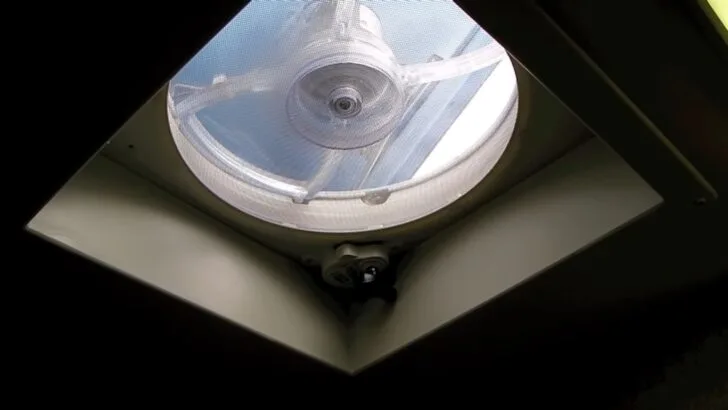




Chuck S
Monday 29th of November 2021
It is hard for me to believe you have not had any problems with Fantastic Fans. Our Newmar, bought new in May or 2017, has had the bath fan replaced 3 times and the kitchen fan replaced 2 times. 3 of the replacements were for control boards gone bad and 2 were for motor gone bad. Trying to get service parts through Dometic is nearly impossible. One of the times I called I was number one in Que for over 5 hours before I hung up. We were without one of the fans for over 5 months while trying to get parts. Should have just bought a new one to be comfortable.
TheRVgeeks
Monday 29th of November 2021
Holy crap, Chuck! So sorry to hear. If that doesn't fit into the old saying "They don't make them like they used to" I don't know what does. Ours are the original 2005 fans, and both have worked flawlessly from day one. Full-time no less, and we run our bathroom fan practically 27/7/365. Hope they never fail.
Dr. Mike
Monday 8th of November 2021
Same subject- different scene. We put our coach in a fully enclosed storage unit with power. Down here in Florida, the unit keeps the sun, dirt, rodents, and rain away. But, the hot Florida sun does a good job of keeping the coach rather warm most of the year.
So, with that introduction, should we have the fans run while she is in storage or just be kept open for ventilation?
TheRVgeeks
Monday 8th of November 2021
Great question, Mike. We'd suggest just leaving them open, but not on. While it will get hot inside, the heat won't harm things, and is really just a comfort issue... which of course isn't an issue during storage. And the fan running won't really make it much cooler anyway, but could be a problem if the circuit breaker tripped and wasn't discovered for several weeks.
Richard Hubert
Sunday 7th of November 2021
Agree with all the points you made about how important vent fans are. In our 38' Class A Winnebago we realized early on that having a 3rd fan mounted over our bed would really help summertime sleeping - so after getting 3 roof structure schematics directly from Winnebago (roof electrical, roof HVAC channels, roof strut locations) I cut a 14x14" hole in the roof over our bed and installed a MaxxAir 7500. Wired it into a close by wall lamp which has 12v to it at all times and it has worked great for years. Love it!
But I have never heard of the high voltage board burnout you mention. We have had solar and BB Lithium batteries for years, running at ~13.6 - 13.8v the entire time - and our MaxxAir fan has run just fine (3+ years). In fact the higher Lithium battery voltages have helped other systems in our RV - in particular our inverters - which seem to prefer a higher voltage as both have shut down in the past (when we had SLA house batteries) due to low voltage. Running slightly higher house system voltage can also help 12v motors such as our furnace fan. When those types of motors are fed a slightly higher voltage their amp draw decreases somewhat, allowing for more efficient operation.
But appreciate your very informative posting about RV roof vent fans - more manufacturers need to read this and understand their importance. Thanks!
TheRVgeeks
Sunday 7th of November 2021
Hi Richard... we just re-read what we wrote about that (and modified it a bit) as it's both the voltage and the consistency of that voltage that appears to be the issue. Non-RV applications (i.e. in a work van) where the voltage is ranging as high as 14.5V due to the vehicle's alternator seem to be the problem. The electronics in the control board aren't robust enough to handle that large a fluctuation (as reported by others in reviews) during operation.
The slightly higher than typical 12V battery voltage (flooded lead acid/AGM batteries are typically between 12.8 and 13.2V) that a Lithium battery provides is, as you mention, not only OK but often preferred... like with 12V motors running at lower amperage.
Glad your bedroom fan is keeping you cool and comfortable at night!
TJL
Sunday 7th of November 2021
I would add one more criteria - ease of cleaning. MY OEM fan works just fine: 3 speeds and the lid can be opened minimally in case of rain. Cleaning, however is very difficult. I can see black dirt built up on and around the blades, but it is very difficult to access even with the screen removed. I end up using Q-tips.
TheRVgeeks
Sunday 7th of November 2021
Thanks for the additional info, TJL!